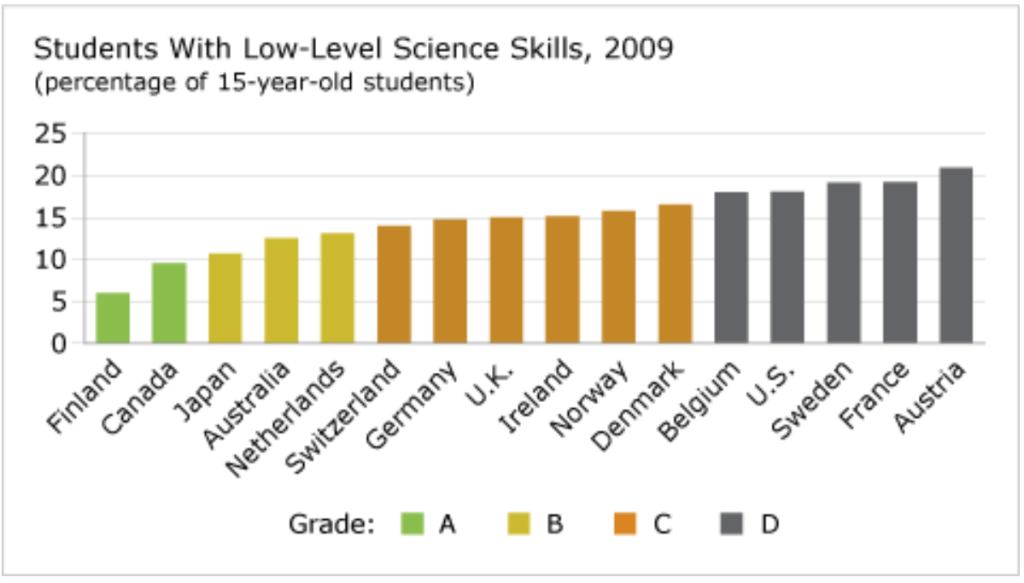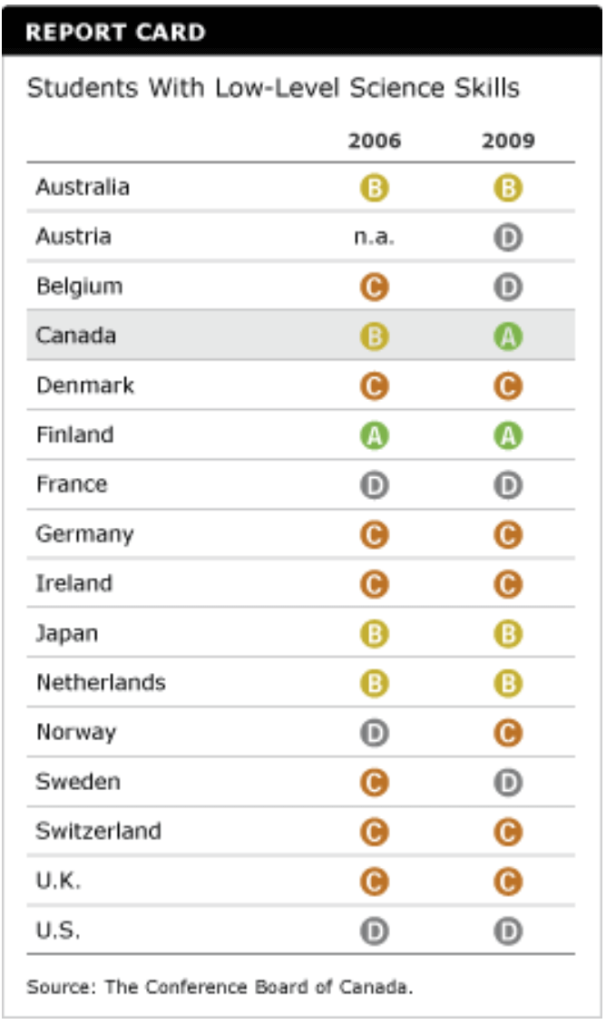Students with Low-Level Science Skills
Key Messages
- Canada gets a “A” grade and ranks 2nd out of 16 peer countries.
- Basic competencies in science are generally considered essential to be able to use new technology.
- Canada does a better job of limiting the number of students with low-level science skills than it does of promoting those with high-level skills.

Putting student science skills in context
The growing role of science, math, and technology in everyday life means science skills are important for all students, not just those aspiring to a career in the sciences. This is a significant shift from the past, when school mathematics curricula were dominated by the need to provide the foundations for the professional training of a small number of mathematicians, scientists, and engineers.1
The Programme for International Student Assessment (PISA) is an international assessment of the skills and knowledge of 15 year olds, coordinated by the Organisation for Economic Co-operation and Development (OECD). It assesses whether students approaching the end of compulsory education have acquired the knowledge and skills essential for full participation in society.
The science component of the PISA test gauges the extent to which students have learned fundamental scientific concepts and theories. It also measures the capacity of students to identify scientific issues, explain phenomena scientifically, and use scientific evidence as they encounter, interpret, and solve real-life problems involving science and technology. This approach reflects the reality of how globalization and computerization are changing societies and labour markets.
Basic competencies in science are generally considered essential to be able to use new technology, while high-level competencies are critical for the creation of new technology and innovation. This makes the acquisition of science skills through the core education system integral to a country’s ability to be successful in the new knowledge economy.
How does the proportion of Canadian students with low-level science skills compare to that of Canada’s peers?
Canada ranks 2nd among 16 peer countries in low-level science skills. Just 10 per cent of Canadian students scored at level 1 or below on the PISA science test. Only 6 per cent of students from Finland, the best performer in the Conference Board comparison, scored that low. Finland’s top performance on the 2009 PISA test significantly raised the bar for an “A” score in our rankings.
Has Canada succeeded in decreasing its share of students with low-level science skills?
Of the 15 peer countries with comparable results in the 2006 and 2009 assessments, 11 decreased their share of students with low-level science skills. Of those 12 countries, the improvement was large enough to move two of them up a grade: Canada and Norway.
Three countries—Belgium, the Netherlands, and Sweden—saw performance deteriorate, with an increase in the share of students with low-level science skills. This deterioration caused two of those countries—Belgium and Sweden—to drop a grade.

What kind of science skills are needed in the workplace?
The Conference Board has developed a tool to help Canadians understand the science competencies they need to participate fully in the world of work.
Science Literacy for the World of Work: Skills Profile (PDF), Ottawa: The Conference Board of Canada.
What can Canada do to improve student science skills?
In 2001, the Conference Board conducted a case study on Let’s Talk Science, a national charitable organization striving to improve scientific literacy through innovative educational programs, research, and advocacy. Understanding how people learn science and how science programs affect children and educators helps Let’s Talk Science develop and deliver the best possible programs, workshops, and activities.
Interested in learning more about Let’s Talk Science?
Let’s Talk Science: Making Science Education Exciting, Relevant and Rewarding, Ottawa: The Conference Board of Canada, 2001.
Footnotes
1 OECD, Learning for Tomorrow’s World: First Results from PISA 2003 (Paris: OECD, 2004), 37.
2 Although the OECD conducted its first student science test in 2000, data on the shares of high- and low-skilled students are not available from that assessment.

